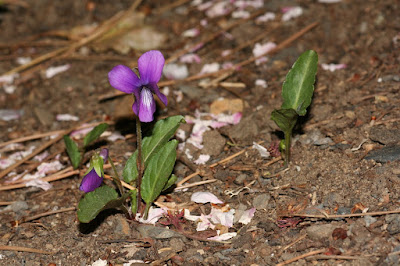 Another weed! Yay! I keyed this one out to the genus Barbarea in Ohwi's Flora of Japan, and it only listed one species, namely Barbarea orthoceras Ledeb., which is called American yellowrocket in English (cool name, right?!), but it's also native to Japan and East Asia. There were some inconsistencies with the leaf shape, among other things, so I looked up some photos of it and decided it was close to the plants I was examining, but not quite right. I then came across some photos of Barbarea vulgaris R.Br., called garden yellowrocket, which matched the plant I had found much better. Sure enough, a search revealed that garden yellowrocket is established in Japan, from Hokkaido to Kyushu.
Another weed! Yay! I keyed this one out to the genus Barbarea in Ohwi's Flora of Japan, and it only listed one species, namely Barbarea orthoceras Ledeb., which is called American yellowrocket in English (cool name, right?!), but it's also native to Japan and East Asia. There were some inconsistencies with the leaf shape, among other things, so I looked up some photos of it and decided it was close to the plants I was examining, but not quite right. I then came across some photos of Barbarea vulgaris R.Br., called garden yellowrocket, which matched the plant I had found much better. Sure enough, a search revealed that garden yellowrocket is established in Japan, from Hokkaido to Kyushu.The plant is a true Eurasian: it's native from Ireland to at least the Urals and India. It may be native t0 western China (eastern Turkistan, a.k.a. Xinjiang), and some sources suggest perhaps all the way to Korea, but I can't find anything completely convincing of either claim. At any rate the plant is very widely distributed in Eurasia and it's biogeography has been giving me a headache, so I'll just assume that it's only native to Europe and Western Asia. It's quite certainly introduced in Japan anyways.
I found this plant in an attempt to find slightly more "natural" plant habitat. It was growing right on the banks of the Toné River (利根川), but the habitat there wasn't a whole lot better than the weedy lots I had been searching up to that point. There were trees and bamboo, but only one species of each. The trees were instantly recognisable: black locust (Robinia pseudoacacia) introduced from the US. It's quite a weedy tree where I'm from as well, but it had really formed a fairly extensive monoculture on the slopes along this river, at least at the canopy level. The bamboo I would have to look at more closely, but it was short and so densely packed that nothing would survive beneath it. The only natives I found were some willows growing in the water.

Anyways, garden yellowrocket is common along ditches, river banks, damp grasslands, roadsides, fields, and in other nondescript disturbed sites. It has a similar floral arrangement to it's cousins, such as the two members of the cabbage family that I've posted on previously. As for seeds and capsules, the plant I photographed hadn't produced any yet, so check the links for photos of those. The leaves seem to be one of the most distinctive features. The upper leaves are ovate, meaning "egg-shaped", to suborbicular, which means "nearly circular", and the margins are usually sinuate (i.e. wavy; see my photo below) to very coarsely dentate (i.e. toothed). The basal leaves are less special; they are lyrate (i.e. lyre-shaped, but more specifically meaning "having a large terminal lobe and smaller rounded lobes toward its base") and form a basal rosette, but on the plant I found they were chewed down to almost nothing. See some of the links for photos of these too.
 The rather long Japanese name of this plant is 春咲山芥子 (ハルザキヤマガラシ; haruzaki-yamagarashi), which means "spring flowering mountain mustard". It's a cousin of the plants whose seeds are used to make mustard (all in the cabbage family, or Brassicaceae), namely Brassica nigra, Brassica juncea, and Sinapis hirta. As an aside, the genus Brassica easily includes more important food plants than any other: cabbage, broccoli, Brussels sprouts, rapeseed, canola, cauliflower, kale, turnip, kohlrabi, collard greens, Chinese cabbage, rapini, rutabaga (or Swede turnip), kai-lan (or Chinese broccoli) and, of course, mustard. Our plant of interest is also called 西洋山芥子 (セイヨウヤマガラシ; "seiyou-yamagarashi"), which means "Western countries mountain mustard". Both names serve to differentiate it from the native Barbarea orthoceras, which is just called 山芥子 (ヤマガラシ; "yamagarashi"), or "mountain mustard".
The rather long Japanese name of this plant is 春咲山芥子 (ハルザキヤマガラシ; haruzaki-yamagarashi), which means "spring flowering mountain mustard". It's a cousin of the plants whose seeds are used to make mustard (all in the cabbage family, or Brassicaceae), namely Brassica nigra, Brassica juncea, and Sinapis hirta. As an aside, the genus Brassica easily includes more important food plants than any other: cabbage, broccoli, Brussels sprouts, rapeseed, canola, cauliflower, kale, turnip, kohlrabi, collard greens, Chinese cabbage, rapini, rutabaga (or Swede turnip), kai-lan (or Chinese broccoli) and, of course, mustard. Our plant of interest is also called 西洋山芥子 (セイヨウヤマガラシ; "seiyou-yamagarashi"), which means "Western countries mountain mustard". Both names serve to differentiate it from the native Barbarea orthoceras, which is just called 山芥子 (ヤマガラシ; "yamagarashi"), or "mountain mustard".The English name, garden yellowrocket, has nothing to do with the things they shoot in to space, but rather is in reference to it being a yellow-flowered plant quite similar to the true rocket, Eruca sativa (a quick examination of the generic name Eruca might clue you in to the fact that the plant name "rocket" is derived from it). Most English speakers would probably know rocket as arugula, the Italian name for the same plant derived from the same root that was introduced in order to make this age-old leaf vegetable seem more exotic.
Links:
Flora of China Treatment
Random Japanese page
MissouriPlants.com entry
Ultraviolet photos of the flowers (what insects see)
















